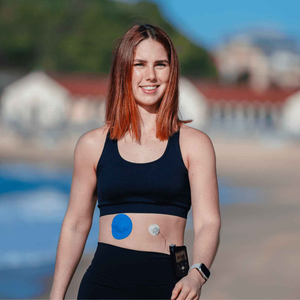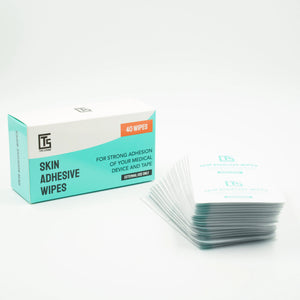This article compares all of the newest continuous glucose monitors on the market. We will review the big four: Freestyle Libre 3, Dexcom G7, Medtronic Guardian 4, and the Eversense E3.
We'll break down five important things: how accurate they are, their size, how long the sensors last, how quickly they start working, and if they need calibration.
Stick around until the end for a detailed look at each device's main features.
Before we continue, At Type Strong, we support individuals with diabetes by providing innovative products like our FreeStyle Libre, Medtronic Guardian & Dexcom G7 adhesive patches. Choose the best CGM for your needs and enhance your experience with our high-quality adhesive patches today!
Let's get started.
ACCURACY
Accuracy is one of the most important areas for any Continuous Glucose Monitor (CGM).
We’re going to rate the accuracy with a metric known as MARD (mean absolute relative difference). MARD has traditionally been used to assess the accuracy of continuous glucose monitoring systems.
MARD is important because it is the standard way to measure CGM accuracy.
Like golf, the lower the number the better.
And, in the world of diabetes, that accuracy is important.
In a nutshell, all you need to know is that the lower the number, the more accurate the CGM.
Keep your CGM secure for the most accurate readings with our hypoallegenic adhesive patches, designed for all major devices.
MEDTRONIC GUARDIAN 4
Let’s start with the Guardian 4 by Medtronic. The Guardian 4 has a MARD of around 10 and a half, depending on the location of the body. The abdomen is about 10.78% MARD and the arm was 10.64 MARD.
DEXCOM G7
Dexcom G7 has a respectable MARD of 8.2% on the upper arm and 9.1% on the abdomen.
EVERSENSE E3
The Eversense CGM had a MARD ranging anywhere from 8.5% to 9.1% MARD.
FREESTYLE LIBRE 3
The Freestyle Libre 3 recently came out with a study revealing the best MARD of any sensor to date at a 7.9% MARD.
Remember: The lower the MARD score, the more accurate the CGM.
|
CGM DEVICE
|
MARD (Most Accurate Score)
|
|
FREESTYLE LIBRE 3
|
7.9%
|
|
DEXCOM G7
|
8.2% - 9.1%
|
|
EVERSENSE E3
|
8.5% - 9.1%
|
|
MEDTRONIC GUARDIAN 4
|
10.64% - 10.78%
|
SENSOR EXPIRATION
Sensor expiration refers to how many days it can be worn before needing to be replaced.
MEDTRONIC GUARDIAN 4
The Guardian 4 lasts a total of 7 days, the same as its predecessor, the Guardian 3.
DEXCOM G7
The Dexcom G7 lasts a total of 10 days, a bit longer than the Medtronic. However, it’s worth noting that Dexcom allows a 12-hour grace period to swap out the sensor before it stops working, giving users around 10.5 days.
Keep in mind the sensor is listed at launch for 10 days, but the company's CEO has hinted that the goal will be a 15-day wear time at some point in the near future.
FREESTYLE LIBRE 3
The Freestyle Libre 3 has a respectable 14-day wear time. Same as the predecessor, Freestyle Libre 2.
EVERSENSE E3
The Eversense blows all the other sensors out with its 180-day wear time.
What needs to be mentioned if you’re unfamiliar with the Eversense CGM is that this is the only CGM that requires a minor surgical procedure to implant the sensor. A very small incision in the arm is made to implant the sensor, which is replaced every 6 months.
While the CGM lasts 180 days, it does require a minor procedure to achieve this long duration. So, keep that in mind.
There is a new model in the works that is expected to last 365 days.
Eversense leads the way at 180 days: keeping in mind that it is implantable. Then, we have Freestyle Libre 3 for 14 days, followed by the Dexcom G7 for 10 days, and finally, the Medtronic Guardian 4 at 7 days wear time.
|
CGM DEVICE
|
SENSOR EXPIRATION
|
|
EVERSENSE E3 (Implantable)
|
180 days
|
|
FREESTYLE LIBRE 3
|
14 days
|
|
DEXCOM G7
|
10 days
|
|
MEDTRONIC GUARDIAN 4
|
7 days
|
SIZE
Let’s talk about the size.
CGM’s are stuck to your body 24 hours a day. So, the smaller definitely, the better.
In CGM wearers, the thickness is the most important measurement to consider. How far will it stick out from your body?
MEDTRONIC GUARDIAN 4
The Guardian 4 comes in at 9.39mm thick.
EVERSENSE E3
The Eversense E3 is 8.8mm thick, slightly thinner than the Medtronic Guardian 4.
The unique selling point of the Eversense E3 is that it can be taken off at any point you’d like, without expiring the CGM. It has double-sided adhesive tape. If you’d like to be able to take off your CGM for short periods, it may be worth considering the Eversense E3.
DEXCOM G7
The new Dexcom G7 is much smaller than its predecessor, the Dexcom G6. It’s thickness measures in at 4.6mm.
The Dexcom G7 and the Freestyle Libre 3 are the smallest of the group.
FREESTYLE LIBRE 3
The Freestyle Libre 3 is the smallest sensor currently on the market. It’s comparable to just two coins stacked on top of one another: coming in at just 2.9mm thick.
We can look at a side-by-side comparison from the largest, the Medtronic Guardian 4, to the smallest sensor out on the market, the Freestyle Libre 3.
|
CGM DEVICE
|
THICKNESS (mm)
|
|
FREESTYLE LIBRE 3
|
2.9
|
|
DEXCOM G7
|
4.6
|
|
EVERSENSE E3
|
8.8
|
|
MEDTRONIC GUARDIAN 4
|
9.39
|
WARM-UP TIME
All CGMs require a warm-up time after placement before you can start using them. Some are a matter of minutes, whereas others take many hours. Let’s compare them one by one.
EVERSENSE E3
The Eversense requires a 24-hour warm-up period, which is by far the longest of all the CGMs. However, that’s the only time you’ll have to warm it up for the entire 180 days that you will be wearing the sensor.
MEDTRONIC GUARDIAN 4
The Guardian 4 has a 2-hour warm-up time. Obviously, a significant change from the Eversense.
FREESTYLE LIBRE 3
The Freestyle Libre 3 has a 1-hour warm-up time.
DEXCOM G7
The shortest warm-up time of all the CGMs is the Dexcom G7, coming in at just 30-minutes.
|
CGM DEVICE
|
WARM-UP TIME (hrs)
|
|
DEXCOM G7
|
0.5
|
|
FREESTYLE LIBRE 3
|
1
|
|
MEDTRONIC GUARDIAN 4
|
2
|
|
EVERSENSE E3
|
24
|
CALIBRATION
Calibration is starting to become a thing of the past as most CGMs no longer require calibration. The Medtronic Guardian 4, Freestyle Libre 3 and Dexcom G7 all do not require calibration, however the Dexcom offers it as an option if you feel it’s not accurate.
The Eversense E3 is the only CGM that requires calibration.
EVERSENSE E3
The first 21 days require two calibrations per day. Following day 21, the CGM only needs one daily calibration (in most cases). Eversense is working on reducing the frequency to around once a week.
The Dexcom G7, Freestyle Libre 3, and Medtronic Guardian 4 require zero calibrations. While the Eversense is still requiring daily calibrations.
|
CGM DEVICE
|
CALIBRATION
|
|
DEXCOM G7
|
NO
|
|
FREESTYLE LIBRE 3
|
NO
|
|
MEDTRONIC GUARDIAN 4
|
NO
|
|
EVERSENSE E3
|
YES
|
You can look at everything together to understand which CGM might be right for you. We hope this article was helpful to you.
WRAPPING UP
In conclusion, this comprehensive comparison of the market's latest continuous glucose monitors (CGMs) highlights crucial factors for potential users to consider. The four major contenders, Freestyle Libre 3, Dexcom G7, Medtronic Guardian 4, and Eversense E3, are evaluated based on accuracy, sensor expiration, size, warm-up time, and calibration.
For those seeking security for their CGM technology, it’s recommended that you explore our CGM Patches. CGM patches offer an alternative and discreet way to experience continuous glucose monitoring, while ensuring they last for their expected duration. Make an informed decision to manage your glucose levels effectively, and check out Type Strong’s adhesive patches, as well as our Medtronic patches, Dexcom g7 patches, omnipod & FreeStyle Libre adhesive patches for a seamless and comfortable experience.





